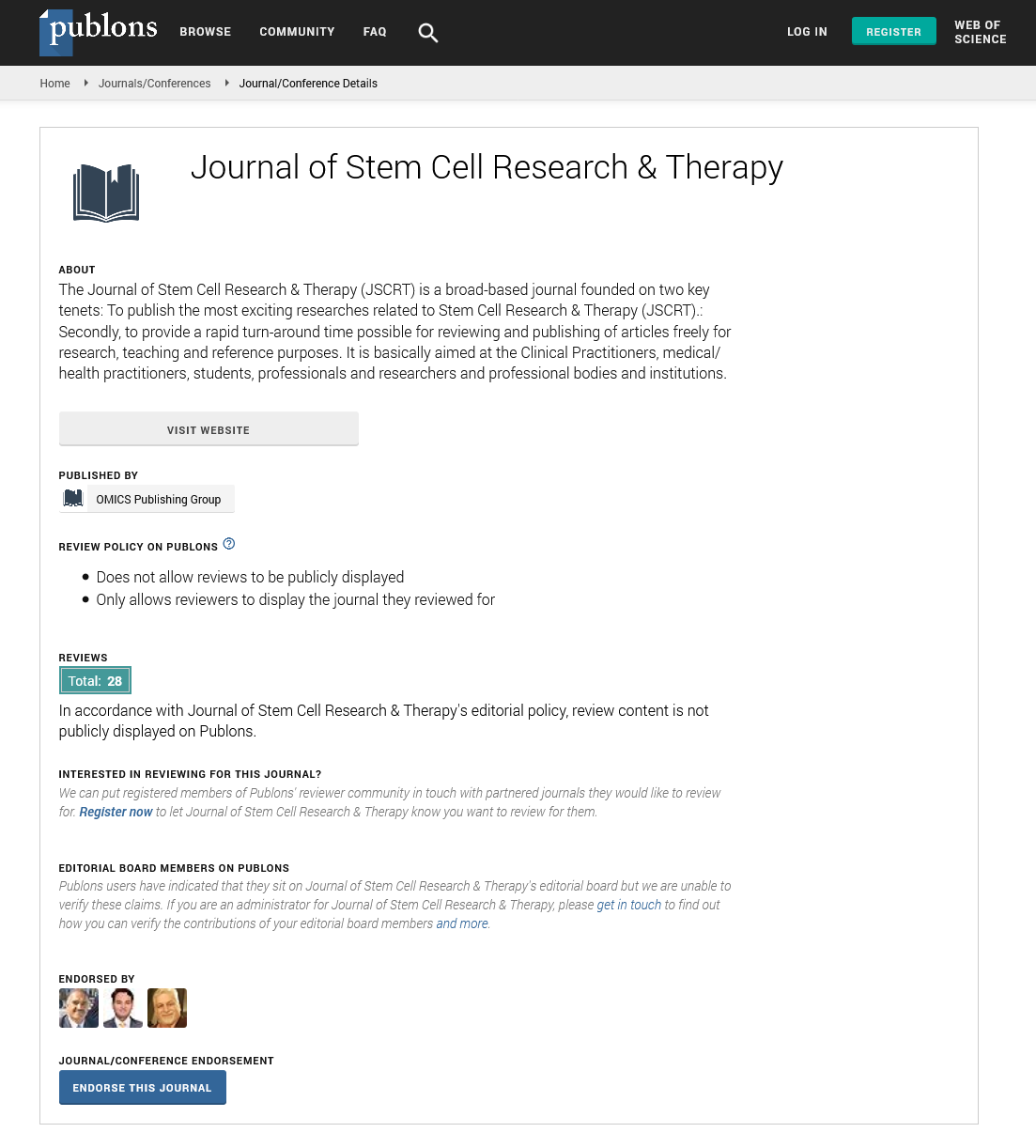Indexed In
- Open J Gate
- Genamics JournalSeek
- Academic Keys
- JournalTOCs
- China National Knowledge Infrastructure (CNKI)
- Ulrich's Periodicals Directory
- RefSeek
- Hamdard University
- EBSCO A-Z
- Directory of Abstract Indexing for Journals
- OCLC- WorldCat
- Publons
- Geneva Foundation for Medical Education and Research
- Euro Pub
- Google Scholar
Useful Links
Share This Page
Journal Flyer

Open Access Journals
- Agri and Aquaculture
- Biochemistry
- Bioinformatics & Systems Biology
- Business & Management
- Chemistry
- Clinical Sciences
- Engineering
- Food & Nutrition
- General Science
- Genetics & Molecular Biology
- Immunology & Microbiology
- Medical Sciences
- Neuroscience & Psychology
- Nursing & Health Care
- Pharmaceutical Sciences
Commentary - (2023) Volume 13, Issue 2
Bone Tissue Engineering using Bone Marrow Stem Cells: Effect of Macroporous Protein Scaffolds
Byoung Kim*Received: 03-Mar-2023, Manuscript No. JSCRT-23-20727; Editor assigned: 06-Mar-2023, Pre QC No. JSCRT-23-20727(PQ); Reviewed: 21-Mar-2023, QC No. JSCRT-23-20727; Revised: 28-Mar-2023, Manuscript No. JSCRT-23-20727(R); Published: 07-Apr-2023, DOI: 10.35248/2157-7633.23.13.587
Description
Adult stem cells fate was thought to be restricted to the tissue from where they originated until just a few years ago. Yet, it has lately been shown that adult stem cells can experience a different fate in some tissues than what is often seen in physiological situations. For instance, bone marrow-derived stem cells can develop into hepatocytes, skeletal muscle, and cardiomyocytes in addition to blood cells. Unexpectedly, recent research has revealed that stem cells can even develop into neural cells in vivo, making them a viable alternative to human embryos for therapeutic transplantation. In fact, the initial plan to replace neurons by various disease events with unharmed heterologous neurons hasn't produced adequate outcomes to date. Contrarily, it is challenging to imagine a method that would allow for the manipulation and re implantation of neural stem cells that have been taken directly from the patient's brain, despite the fact that the discovery of the presence of neural stem cells in the adult human brain, for a review see is unquestionably a milestone in the field. In light of this, the source embodied by bone marrow provides theoretically limitless therapeutic uses.
Hematopoietic stem cells, which produce red blood cells, platelets, monocytes, granulocytes, and lymphocytes, and nonhematopoietic stromal cells, which are more recently recognized as having a mesenchymal nature due to their capacity to distinguish into myogenic, osteogenic, chondrogenic, and adipogenic lineages, are the two main subpopulations of stem cells that can be found in bone marrow. By adhering to plastic culture dishes, BMSC can be isolated from complete bone marrow. Recent research has demonstrated that under appropriate experimental circumstances, BMSC can be made to develop a neuronal phenotype in vitro. For instance, Woodbury et al. found that BMSC can develop into cells that express neuron specific enolase and neuro filament in the presenc of mercapto ethanol and dimethyl sulfoxide. It has also been shown that stromal cells distinguish into neural cells that express both neuronal and glial markers (Neu-N, nestin, GFAP) in the existence of Epidermal Growth Factor (EGF) and Brain-Derived Neurotropic Factor (BDNF). This shows how factors that can increase intracellular cAMP induce the differentiation of BMSC into initial progenitors of neural stem cells. Unfortunately, it is not possible to compare these methods due to the variations in BMSC separation and culture conditions, as well as in the characterization of differentiated cells. For this reason, we looked at the various outcomes of two distinct therapies for BMSC differentiation into a neuronal phenotype. Recent research has demonstrated that the preservation of brain precursor cells in an undifferentiated state depends on transcription factor with helix-loop-helix (bHLH) motifs . Mammalian Hairy and Enhancer of Split genes (Hes1, Hes3, and Hes5) are a subset of bHLH genes; Hes1 in particular is strongly expressed by neural stem cells. Our findings demonstrate that Hes1 participates in the differentiation of BMSCs into neural cells. In fact, following both treatments, neural precursors showed a brief rise in this transcription factor.
Citation: Kim B (2023) Bone Tissue Engineering using Bone Marrow Stem Cells: Effect of Macroporous Protein Scaffolds. J Stem Cell Res Ther. 13:587.
Copyright: © 2023 Kim B. This is an open-access article distributed under the terms of the Creative Commons Attribution License, which permits unrestricted use, distribution, and reproduction in any medium, provided the original author and source are credited.

